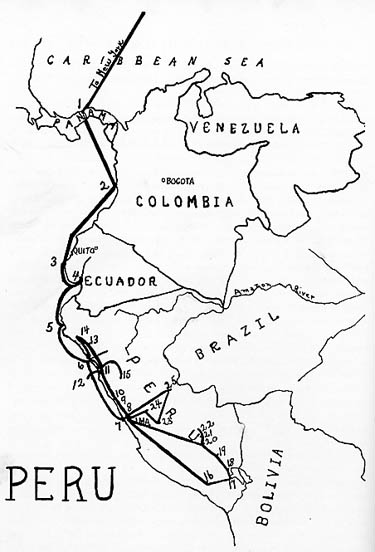

1. Panama
10. Huaura
19. San Rosa
2. Buenaventura
11. Chimbote
20. Cuzco
3. Manta
12. Santa Island
21. Calca
4. Guayaquil
13. Chiclayo
22. Manchu Piccu
5. Talara
14. Eten
23. Huancayo
6. Trujillo
15. Huaraz
24. Oroya
7. Callao
16. Arequipa
25. Perene
8. Lima
17. Lake Titicaca
9. Huacho
18. Juallanca
Chapter 13
Ancient civilizations of Peru
IN THE foregoing field studies among primitive races we have been dealing chiefly with living groups. Since the West Coast of South America has been the home of several ancient cultures, it is important that they be included with the living remnants of primitive racial stocks, in order to note the contributions that they may make to the problem of modern degeneration. The relationship between the Andes Mountain Range and the coast and the sea currents is such that there has been created a zone, ranging from forty to one hundred miles in width between the coast and the mountains, which for a distance of over a thousand miles is completely arid. The air currents drifting westward across South America from the Atlantic carry an abundance of moisture. When they strike the eastern foothills of the Andes they are projected upward into a region of constant cold which causes the moisture to be precipitated as rain on the eastern slopes, and as snow on the eastern Cordillera Range. Hence the name of the eastern range is the White Cordillera, and that of the western range, which receives little of this rain, is the Black Cordillera. Between these two ranges is a great plain, which in the rainy season is well watered. The great civilizations of the past have always utilized water from the melting snow through irrigation ditches with the result that a vast acreage was put to agricultural uses.
The Humboldt Current which sweeps northward from the southern ice fields and carries its chilly water almost to the equator has influenced the development of the West Coast of South America. The effect of the current on the climate is generally noticeable. One of the conspicuous results is the presence of a cloud bank which hovers over the coastal area at an altitude of from one thousand to three thousand feet above sea level for several months of the year. Back from the coast these clouds rest on the land and constitute a nearly constant fog for extended periods. When one passes inland from the coast up the mountains he moves from a zone which in winter is clammy and chilly, into the fog zone, and then suddenly out of it into clear sky and brilliant sunlight. It is of interest that the capital, Lima, is so situated that it suffers from this unhappy cloud and fog situation. When Pizarro sent a commission to search out a location for his capital city the natives commented on the fact that he was selecting a very undesirable location. Either on the coast or farther inland than Lima the climate is much more favorable, and these were the locations in which the ancient civilizations have left some very elaborate foundations of fortresses and extended residential areas. The great expanse of desert extending from the coast to the mountains, with its great moving sand dunes and with scarcely a sign of green life, is one of the least hospitable environments that any culture could choose. Notwithstanding this, the entire coast is a succession of ancient burial mounds in which it is estimated that there are fifteen million mummies in an excellent state of preservation. The few hundred thousand that have been disturbed by grave robbers in search of gold and silver, have been left bleaching on the sands. Where had these people come from and why were they buried here? The answer is to be found in the fact that probably few locations in the world provided such an inexhaustible supply of food for producing a good culture as did this area. The lack of present appreciation of this fact is evidenced by the absence of flourishing modern communities, notwithstanding the almost continuous chain of ancient walls, fortresses, habitations, and irrigation systems to be found along this coast. The Humboldt Current coming from the ice fields of the Antarctic carries with it a prodigious quantity of the chemical food elements that are most effective in the production of a vast population of fish. Probably no place in the world provides as great an area teeming with marine life. The ancient cultures appreciated the value of these sea foods and utilized them to the full. They realized also that certain land plants should be eaten with the sea foods. Accordingly, they constructed great aqueducts used in transporting the water, sometimes a hundred miles, for the purpose of irrigating river bottoms which had been collecting the alluvial soil from the Andes through past ages. These river beds are to be found from twenty to fifty miles apart and many of them are entirely dry except in the rainy season in the high Andes. In the river bottoms these ancient cultures grew large quantities of corn, beans, squash, and other plants. These plant foods were gathered, stored, and eaten with sea foods. The people on the coast had direct communication with the people in the high plateaus. It is of more than passing interest that some twenty-one of our modern food plants apparently came from Peru.
Where there is such a quantity of animal life in the sea in the form of fish one would expect to find the predatory animals that live on fish. One group of these attack the fish from the air and they constitute the great flock of guanayes, piqueros and pelicans. For a thousand miles along the coast, these fish-eating birds are to be seen in great winding queues going to and fro between the fishing grounds and their nesting places. At other times they may be seen in great clouds, beyond computation in number, fishing over an area of many square miles. On one island I was told by the caretaker that twenty-four million birds had their nests there. We passed through a flock of the birds fishing, which the caretaker estimated to contain between four and five million birds. On one island I found it impossible to step anywhere, off the path, without treading on birds' nests. It is of interest that a product of these birds has constituted one of the greatest sources of wealth in the past for Peru, namely, the guano, which is the droppings of the birds left on the islands along the coast where they have their nests. Through the centuries these deposits have reached to a depth of 100 feet in places. When it is realized that only one-fifth of the droppings are placed on the islands, it immediately raises the great question as to the quantity of fish consumed by these birds. As high as seventy-five fish have been found in the digestive tract of a single bird. The quantity of fish consumed per day by the birds nesting on this one island has been estimated to be greater than the entire catch of fish off the New England coast per day.
In addition to the birds, a vast number of sea lions and seals live on the fish. The sea lions have a rookery in the vicinity of Santa Island, which was estimated to contain over a million. These enormous animals devour great quantities of fish. It would be difficult to estimate how far the fish destroyed by this one group of sea lions would go toward providing excellent nutrition for the entire population of the United States. The guano, consisting of the partially digested animal life of the sea, constitutes what is probably the best known fertilizer in the world. It is thirty-three times as efficient as the best barnyard manure. At one time it was sent in shiploads to Europe and the United States, but now the Peruvian Government is retaining nearly all of it for local use. They have locked the barn door after the horse was stolen, figuratively speaking, since the accumulation of ages had been carried off by shiploads to other countries before its export was checked. At the present time all islands are under guard and the birds are protected. They are coming back into many of the islands from which they had been driven and are re-nesting. Birds are given two or three years of undisturbed life for producing deposits. These are then carefully removed from the surface of the islands and the birds are allowed to remain undisturbed for another period.
A very important and fortunate phase of the culture of the primitive races of the coast has been their method of burial. Bodies are carefully wrapped in many layers of raiment often beautifully spun. With the mummies articles of special interest and value are usually buried. Implements used by the individuals in their lifetime were also put in the grave. With a fisherman there were placed his nets and fishing tackle. Almost always, jars containing foods to supply him on his journey in the transition to a future life were left in the tomb. In some of the cultures the various domestic and industrial scenes were reproduced in pottery. These disclosed a great variety of foods which are familiar to us today. Even the designs of their habitations were reproduced in pottery. Similarly their methods of performing surgical operations, in which they were very skillful, were depicted. Fortunately, the different cultures had quite different types of pottery as well as quite different types of clothing. This makes it possible to identify various groups and indicate the boundaries of their habitations.
Their engineering feats disclosed skill in planning fortresses. Their forts were probably impregnable from assault in that day. The materials used for building their temples, abodes, and fortifications differ somewhat in various locations. Throughout the greater extent of the coast of Peru, the walls of buildings were made of adobe often many feet thick and sometimes sixty feet high. They had walled cities protected by inner and outer lines of fortifications. It is particularly significant that the hardest metals that they are known to have had were copper and bronze. Silver and gold were quite plentiful. Their surgical instruments were flints and the operations that they were able to perform with these instruments were very remarkable. An important instrument in warfare consisted of a club with a star on the end made of copper or stone. With this the opponent's skull was crushed in. One of the amazing features in the various collections of skulls is the large number that show the results of surgical operations. These operations were apparently done for the purpose of saving the life of the individual. The procedure was to remove a section of bone in the center of the depressed area and raise the depressed edges surrounding that area. The fact that a large number of these show abundant evidence of healing and repair clearly indicates that the individual lived for an extended period following the operation. In some cases, the opening is apparently entirely closed in with new bone. Some of these trepanning operations removed a quantity of bone over an area large enough for a human hand to pass through. A group of these operated skulls are shown in Fig. 75. The owner of the one on the lower row, left, probably died following the operation, as there is no evidence of repair. The others show good healing, which in some is very extensive. A study of these trephined skulls reveals that 62 per cent lived for months or years. In Fig. 75 (lower right), is seen a skull which shows a large operation. A part of the surgical procedure was to place a plate of gold over the opening in the skull for protection. One of these is shown in the upper half of Fig. 76. Below is shown the healed scar after removal of the gold plate.
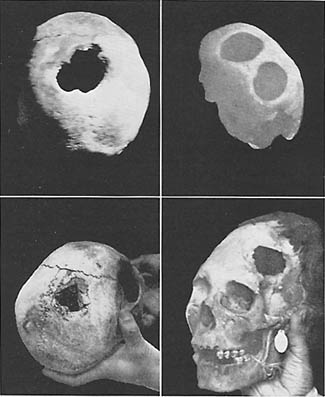
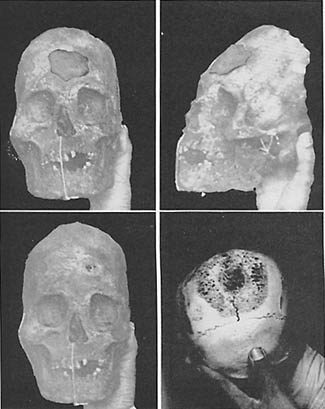
The skill of the surgeons in amputations is illustrated by the pottery reproductions of amputated parts. One of these, for example, shows a man with an amputated foot holding the stump of his leg with one hand while putting on a sock over the end of the stump with the other hand. The technic of amputation is shown in pottery form in Fig. 77. A serious disease of the foot is suggested, requiring amputation of the leg, high up. Note how the thigh bone was cut so as to provide a fleshcovered stump. Below in Fig. 77 is shown a healed oblique fracture with good adaptation.

When the Spaniards arrived to carry forward the conquest of Peru they found the entire coastal area and upper plateaus under the control of a culture organized under the Inca rulers. Prior to the domination of that culture, which had its origin in the high plateau country, several other cultures had developed along the coast in succeeding eras of domination. In northern Peru the Chimus developed a great culture that extended over a long period of time. Their capital city was at Chan Chan, inland from the present coastal port of Saliverry and near Trujillo. This city is estimated to have contained a million people. The argument is sometimes presented that at the time these ancient cultures lived the coastal areas were not arid desert but well supplied with rain. That this was not so is clearly evidenced by the fact that the walls were built of stucco made by mixing water with the available sand and rubble either in continuous molds or in blocks that were built into the fort. Since these blocks were only sun-dried they had very little resistance to rain. In this rainless desert land they have continued to stand through many centuries, many of them probably through several thousand years. There has been a vast change in the walls of the ruined city of Chan Chan within a decade and a half.
In 1925 this district was visited by a heavy downpour of rain which apparently exceeded any precipitation, not only through historic times, but for many centuries preceding. Temples, courtyards and military defenses which were in splendid preservation before that downpour were reduced to a mere semblance of their former structure. Clearly these great cities and their defenses could not have been built of this material in the period when downpours were even occasional, let alone frequent.
It was, of course, the wealth of the ancient cultures that spurred on the conquistadors. It is very difficult to estimate the per capita quantity of gold available in those early cultures. That gold and silver were abundant is evidenced by the extensive use that was made of these metals for covering the walls of rooms and decorating public buildings with massive plates, sometimes entirely encircling a building and the walls of its various rooms. A considerable quantity of gold and silver has been taken from the burial mounds. One burial mound is reported to have yielded between six and seven million dollars worth of gold. So great has been the activity of the grave robbers that the Peruvian Government has placed a ban on this enterprise though for a period it was allowed on condition that a stated percentage was given to the Government.
One of the principal characteristics of the Chimu culture of the coastal area of northern Peru is shown in the type of pottery they produced. All articles were realistic in design. The pots show hunting scenes, fishing and domestic scenes, as illustrated above. They were very skillful in reproducing features in nearly natural size. Many thousands of these portrait jars have been taken from the mounds of this district. The local museum in the vicinity of Chan Chan, under the skillful direction of Mr. Larco Herrera at Chiclyan was reported to contain over twenty thousand jars and specimens taken from the mounds.
To the south of the domain of the Chimu culture, a very strong culture was built up with very different characteristics known as the Naska. While many of their habits of life, including their methods of providing food, were similar to those of the Chimu culture, they were unique in the designs of their pottery, which were characterized by being allegorical. They used elaborate color designs and fantastic patterns. Very little is known as yet of the meaning of much that they have left. While sundials of ancient design and build have been found in many parts of Peru, it is not known to what extent they developed a knowledge of astronomy. The pilot of the plane that flew us from Lima to Arequipa took us over some very strange architectural designs of geometrical patterns which he had discovered and which he suggested had not been reported upon nor interpreted. I photographed some of these from the air. The straight lines constituting the sides of some of the geometric figures are over a thousand feet long and reveal a precision of the angles and a straightness of the ground structures which indicate the use of competent engineering equipment and a high knowledge of surveying.
One of the principal purposes of my trip to Peru was to study the effect of the Humboldt Current, with its supply of human food, on the ancient cultures which were buried along the coast. In other parts of the world, where Nature had provided the sea with an abundance of sea life which was being utilized by native races, I found quite routinely excellent physical development with typical broad, well-developed facial forms and dental arches with normal contours. In each of these groups, the people have reproduced quite closely the racial type in practically all members of the group. I have emphasized with illustrations this fact in connection with the Melanesians and Polynesians on eight archipelagos of the Pacific Ocean, the Malay races on the islands north of Australia, the Aborigines of Australia along the east coast; also the Gaelics in the Outer Hebrides, and the Eskimos of Alaska.
The activity of grave robbers in the ancient burial mounds has left skeletons strewn helter skelter where many of them have been weathering, probably for years. While many of these had apparently been deliberately smashed, large numbers were intact, and in a good state of preservation. Some of the ancient cemeteries apparently extended over areas covering a square mile; and as far as the eye could see the white bleaching bones, particularly the skulls, dotted the landscape. Since there were several distinct cultures, I endeavored to make a cross section study of a number of these burial grounds in order that a fair average of specimens might be obtained. The skulls were handled by me, personally, and large numbers of them were photographed. As I have mentioned, it was the ancient custom when making the burials to inter objects that were of special interest to the individuals, including the implements with which he had worked. Fishermen's skulls are shown in Fig. 78 with their nets. It will be noted that all these arches are broad and wide, that the third molars are well formed and almost always well developed, and in good masticating position. Notwithstanding the long period of interment the fabrics buried with these people were often in a remarkably good state of preservation. Even the hair was well preserved. A characteristic of the method of preparation for burial involved placing over the teeth a preparation that was held in position by a strip of cloth which cemented the teeth quite firmly to this strip with the result that when the mummy cases were torn open the removal of this bandage removed the straight rooted teeth, and therefore large numbers of the skulls that were bleaching on the sandy wastes were without the straight rooted teeth. Of course, these would readily tumble out at the slightest jar, after the mummified tissues had decomposed from exposure. The teeth lost in this way would include practically all of the upper and lower incisors, some of the bicuspids and third molars.

Since our study was primarily concerned with the shape of the dental arches and facial form, these characteristics could be studied and recorded with the straight rooted teeth removed. Fortunately, there are some excellent collections of skulls in museums in Peru, with the skulls in position where they can be readily studied for the shape of the dental arches. When we have in mind that from 25 to 75 per cent of individuals in various communities in the United States have a distinct irregularity in the development of the dental arches and facial form, the cause and significance of which constitutes one of the important problems of this study, the striking contrast found in these Peruvian skulls will be seen to constitute a challenge for our modern civilizations. In a study of 1,276 skulls of these ancient Peruvians, I did not find a single skull with significant deformity of the dental arches.
Since these investigations have apparently established the fact that this problem is related directly to nutrition, and chiefly to nutrition in the formative period, and, as we shall see, to a very early part of the formative period, we have here evidence of a system of living that is very closely in accord with Nature's fundamental laws of reproduction. Several studies have been made dealing with the incidence of dental caries or tooth decay among these ancient cultures. The author of "Bird Islands of Peru" (1) states that in his examination of fifty mummies in succession he found only four with a tooth with dental caries. This again is in striking contrast to our modernized communities in which from 95 to 100 per cent of all the members of a community group suffer from dental caries. I have shown in connection with the Indians of the western coast of Canada that in six highly modernized communities where the Indians were using white man's foods, 40 per cent of all the teeth had been attacked by dental caries. A similar high percentage was found in the Indians now living in Florida. The ancient burials in southern Florida revealed apparent, complete immunity. These were pre-Columbian burials.
The skill of the primitive cultures of Peru in engineering as evidenced by the irrigation systems has always been a subject of amazement to modern engineers. I visited in a valley fifteen miles from the Santa River an ancient aqueduct which was said to be a hundred miles long. Our guide informed me that he had walked in it for thirty-five miles. With its even grades, overflows and auxiliary channels for distribution, its adaptation to the area to be watered, and the skill with which it was cut through rock shoulders and its retaining walls built, it constitutes a monument to engineering ability. Modern engineers have estimated that this aqueduct could deliver sixty million cubic feet of water a day. In Fig. 79 will be seen a section where it has been carried through a rock cutting and beyond will be seen a retaining wall used to carry the flume along the sheer face of a rock. The modern inhabitants of this community have carried away this retaining wall for use in the foundations of their huts. Below, in Fig. 79, will be seen a district of many hundreds of acres, possibly a thousand, where the fields are laid out just as they were left hundreds of years ago when the primitive people were driven from this habitat. All this valley needs is water.
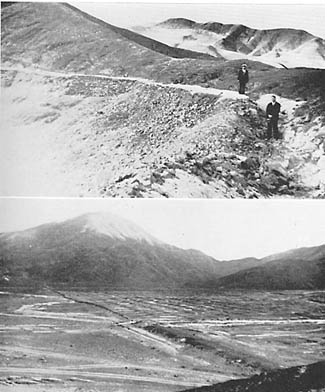
In order to reach the burial places it was necessary to drive many hundreds of miles over the arid desert inland from the coast. We were exceedingly fortunate in having as our interpreter and guide Dr. Albert Giesecke, who for fourteen years was the Chancellor of Cuzco University. With his excellent knowledge of the country and its languages, with the credentials which gave us entry to the secluded places, together with the kindness and helpfulness of the Peruvian Government officials in almost all localities, we were able to obtain much valuable information. In an estimate of this culture not only their arts, but their scientific skill should be included.
Since the primary object of this quest was to learn of the efficiency of these primitive people in the art of living in harmony with Nature's laws and their methods for accomplishing this, it was desirable to find, if possible, some living descendants of these people to gain from them the information that had been handed down. We were told that there were a few villages in an isolated section of the coast in northern Peru where the inhabitants claimed descent from the ancient Chimu cultures of that area. This group was characterized by a flattening of the skull at the back which classified them as short heads and is readily identified. We were very fortunate in having the assistance of Commander Daniel Matto of the Peruvian Army. He was able to utilize the police facilities for locating typical old residents who could tell us much of the story of their race and its recent history as it had been handed down by word of mouth. In Fig. 80 will be seen one of these nonagenarians. He told us of incidents that had been related to him by his great-greatgrandfather and by the old people of that area, of the coming of Pizarro four hundred years ago. The height of this man can be judged as he is seen standing beside Mrs. Price, who is five feet three. His head is shown both front and side view, revealing the flattened surface at the back. An ancient skull with typical flattening is also shown. Fortunately these people are living very closely in accordance with the customs of their ancestors. They are fisherfolk, with a hardihood and skill that is in striking contrast with the lethargy of the modernized groups. Their fine physical development, the breadth of their dental arches and the regularity of their facial features are in striking contrast to the characteristics noted among individuals in the modernized colonies. In Fig. 81 will be seen typical members of these colonies.
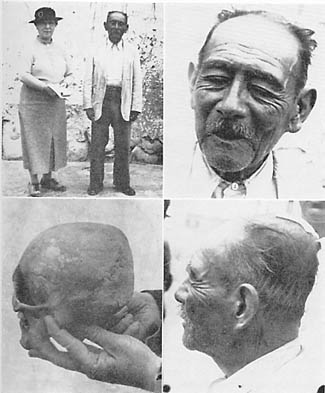
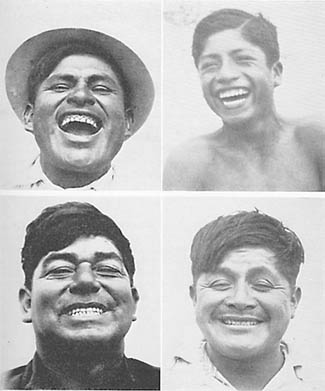
The skill with which these men manage their fishing boats is inspiring. Even though the surf was rolling in great combers they did not hesitate to go out in either their small crafts carrying one individual or in their large sailboats carrying a dozen men. The abundance of the fish in this district is demonstrated by the large catch that each succeeding boat brought to shore.
At the time the Spanish Conquistadors arrived in Peru one of the most unique of the ancient cultures held sway over both the mountain plateaus and the coastal plains from Santiago of Chile northward to Quito, Equador, a distance of about 1200 miles. This culture took its name from the ruling emperors called Incas. The capital of their, great kingdom was Cuzco, a city located between the East and West Cordillera Ranges of the Andes. These parallel ranges are from fifty to two hundred miles apart. Between them is situated a great plateau ranging from 10,000 to 13,000 feet above the sea. The mountain ranges are snow-capped and include in Peru alone fifty peaks that are over 18,000 feet in altitude, ranging up to 22,185 feet in Mount Huascaran. Only Mount Aconcagua in Chile is higher. It is 23,075 feet--the highest mountain in the Americas. The air drift is across South America from east to west, carrying vast quantities of water received by evaporation from the Atlantic Ocean. This moisture is precipitated rapidly when the clouds are forced into the chill of the higher Andes. In the rainy season the great plateau area is frequently well watered, though not in sufficient quantity to meet the needs of agriculture for much of the territory. In the past the precipitation has been supplemented by vast irrigation projects using the water from the melting snows. It is estimated that the population ruled over by the reigning Incas at the time of the coming of the Spaniards reached five millions.
It is probable that few, if any, of the ancient or modern cultures of the world have ever attained a more highly perfected organization of society than had this Inca culture. The ruling Inca was a benevolent despot, and according to history unique in that he practiced most diligently all of the laws he promulgated for his people. There was no poverty, want or crime. Every man, woman and child was specifically provided with all necessities. The entire amount of tillable land was divided so that every man, woman and child had his assigned parcel. Everyone worked as assigned by the proper official. While it is not appropriate here to go into details, it is important that we have a bird's eye view of this great culture for which I will quote a paragraph from Agnes Rothery's "South America, The West Coast and The East." (2)
The people who erected this temple lived in order and health, under the most successful communism the world has ever seen. Their land was divided into three portions--one portion for the Inca, one for the Sun, and one for the people, with seventy square meters for every boy and thirty-five for every girl. The live stock and implements were similarly apportioned and the land was ploughed, planted, and the crops gathered in strict rotation. First the fields of the Sun were cultivated, and then the land of the aged, the sick, widows, and orphans was tended; then the lands of the people, neighbors assisting one another; and last of all the lands of the Inca, with songs of praise and joy, because this was the service of their King. To every living soul was given his tasks, according to his physical and mental capacities. He was prevented from overwork, prohibited from idleness, cared for in illness and old age. Children were taken by the Government when they were five and trained to the profession where they were most needed. There was no hunger, no crime in the whole empire.
The Inca held his kingly office over the docile, industrious, and contented mass not only through his royal blood, but through his wisdom and kindness in caring for and guiding his subjects, his bravery in war, and his statesmanship at home. Although he set an example to his subjects by following every law which he promulgated (astonishing idea to our modern lawmakers!), he lived, as became his rank, in luxury. In his garden were rows of corn moulded from pure gold with leaves of pure silver, and a tassel of spun silver, as fine as silk, moving in the air. Llamas and alpacas, life-sized and cunningly fashioned from the same metal, stood upon his lawns, as they did in the courts of the Temple of the Sun.
Cuzco, the capital, is reported to have housed about two hundred thousand people at the time of the Spanish Conquest. It is situated on a branch of the Urabamba River in a beautiful valley surrounded by fertile mountain sides and towering snow-capped pinnacles. The Urabamba River drains a large area of the plateau lying to the south of Cuzco and has cut a magnificent gorge through the southern range of the Andes where it passes from the plateau to the eastern watershed and thence to the Amazon. A little to the south of Cuzco the eastern and the western ranges of mountains approach and combine in a cluster of magnificent pinnacles and intervening valleys and gorges, that are to be equalled by no mountain scenery in the world. Today, almost all travel from the Andean Plateau north of this region, as well as from all areas along the coast, must proceed to the coast, thence down the coast by boat to the port of Mollendo which is often dangerous or impossible of approach because of the heavy seas. The journey is made by train up through Arequipa and over the western Cordillera Range of the Andes into the plateau country and from there northward to Cuzco. So great is this natural barrier that the detour requires many days, and the crossing of several divides ranging from fourteen to sixteen thousand feet above the sea. This was not necessary for the Incas who had built roads and suspension bridges through these mountains from Cuzco to all parts of the great empire. It is in this mountain vastness that the Inca rulers had constructed their most superb fortresses. While the early Spanish conquerors of the country knew that the nobility had great defenses to which they might retreat, the location of the fortresses was not known. Their greatest fortress was discovered and excavated by Professor C. W. Bingham of Yale, under the auspices of Yale University and the American Museum of Natural History. This fortress and retreat is now world famous as Macchu Piccu, and probably represents the highest development of engineering, ancient and in some respects modern, on the American continent.
We are particularly concerned with the type of men that were capable of such great achievement, since they were required to carry forward their great undertakings without the use of iron or the wheel. While the great Inca culture dominated the Sierras and the coast for several centuries prior to the coming of the Spanish, and while they had their seat of government and vast agricultural enterprises in the high Sierras, it is of special interest that many of the most magnificent monuments remaining today in stone were not constructed by the Inca culture, but by the Tauhuanocan culture which preceded the Inca. The Incas were a part of the Quechu linguistic stock, while the Tauhuanocans were a part of the Aymara linguistic stock. The Incas had their capital in the high plateau country about the center of Peru. The earlier Tauhuanocan culture centered in southern Peru near Lake Titicaca where their most magnificent structures are to be found today. One of the largest single stones to be moved and put into the building of a great temple in the history of the world is to be found near Lake Titicaca. According to engineers, there is no quarry known in an easily reached locality where such a stone could be quarried. It is conjectured that it was brought two hundred miles over mountainous country. It is important to note that many magnificent structures, evidently belonging to this ancient Tauhaunocan culture, are found distributed through the Andean Plateau from Bolivia to Equador. Their masonry was characterized by the fitting together of large stones faced so perfectly that in many of the walls it was difficult to find a crevice which had enough space to allow the passage of the point of my pen knife, notwithstanding that these stones were many-sided with some of them fifteen to twenty feet in length. In Figure 82 above will be seen a section of wall of the great fortress Sacsahuaman overlooking Cuzco. Modern engineers seem unable to provide a satisfactory answer as to how these people were able to cut these stones with the limited facilities available, nor is it explained how they were able to transport and hoist some of their enormous monoliths. The walls and fortress of Macchu Piccu, as well as the residences and temples, were built of white granite which apparently was taken from quarries in the bank of the river Urabamba, two thousand feet below the fortress. Without modern hoisting machinery, how did they raise those mammoth stones? In Fig. 82 below is shown a typical section of wall. One stone shown has twelve faces and twelve angles, all fitting accurately its boundary stones. It is as though the stones were plastic and pressed into a mould.
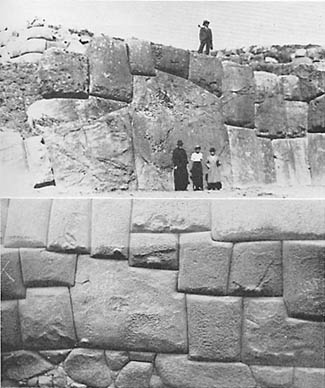
The country is rugged. Over it passes the highest standard-gage railroad in the world,--about 16,000 feet above sea level. The banks of this river are protected for long distances by ancient stone retaining walls. The native Indians live and herd their flocks of llamas and alpacas up near the snow line, largely between 15,000 and 18,000 feet. The Incas and their descendants now occupying the high Sierras in the Andes have been thrifty agriculturists. They turn the soil with a very narrow, long, slender bladed spade which they force into the ground, and with which they pry the ground up in chunks. They then break up the chunks. These spades were originally made of copper which they mined themselves. Cuzco is the archeological capital of South America, but its glory is in the ancient fortresses and temples, rather than in the modern structures. As one passes through the streets, he will note that in many instances the foundations and parts of the walls of many of the modern Spanish cathedrals and public buildings are of old Inca construction, of fine stone work surmounted by cheap rubble work and mortar superstructure. Whereas the original Cuzco had running water and an excellent sanitation system, modern Cuzco has deplorable sanitary conditions. The following is quoted from the West Coast Leader, published in Lima, dated July 20, 1937: "Of a total 3,600 houses in the city of Cuzco 900 are without water or drainage; 2,400 are without light (windows) and 1,080 completely lack any sanitary systems. It is not surprising, therefore, that in some years the death rate exceeds the birth rate.
We are particularly concerned in studying these people to know the sources of their great capacity for developing art, engineering, government and social organization. Can such a magnificent culture be brought about unless founded on a superb physical development resulting from purely biologic forces?
Earthquakes are very frequent in the Andes. We experienced several while in Peru. One of these opened up a cave in the mountainside in the Urabamba Valley near which we were making studies. The cave had just been explored and a number of ancient burials found. I was able to examine a number of skulls from this cave which apparently represented a pre-Spanish period. The date of the burials could not be determined. The skulls were interpreted as belonging to an early Indian period. In Fig. 83 may be seen two typical skulls. Note the broad sweep of the dental arches and freedom from tooth decay. The third molars (wisdom teeth) are well developed and in normal position for mastication. These are typical of the entire group found in this burial place. It is very evident that these individuals were provided with an adequate nutrition throughout the formative and growth periods, as well as during their adult life. This is significant because of the limited variety of foods easily obtainable for the people in the high plateau country of the Andes.
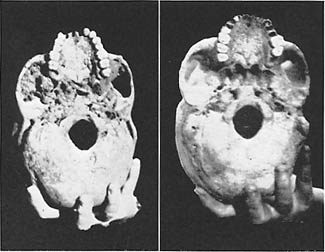
The ancient Peruvians of both the coastal area and high plateau country had developed superb physical bodies in each of the several cultures. This development had been brought about in spite of the bad conditions prevailing with arid desert land extending from the coast to the mountains, and in spite of the severe climate of the high Sierras. The people utilized the wide variety of animal life from the sea in conjunction with the excellent plant foods grown in the river basins with the aid of irrigation. Over twenty of our common plants had their origin in ancient Peru. In the high Sierras, their animal foods were largely limited to the llama, alpaca and wild animals. Each household, however, maintained a colony of guinea pigs. Owing to the difficulty of boiling in the high altitudes, they found it necessary to roast their cereals and meats. Their vegetable foods included potatoes, which were preserved in powder form by freezing and drying and pulverizing. Corn and several varieties of beans and quinua were their principal cereals. The latter is a small seed of very high nutritive value.
REFERENCES
Next
Table of Contents
Back to the Small Farms Library